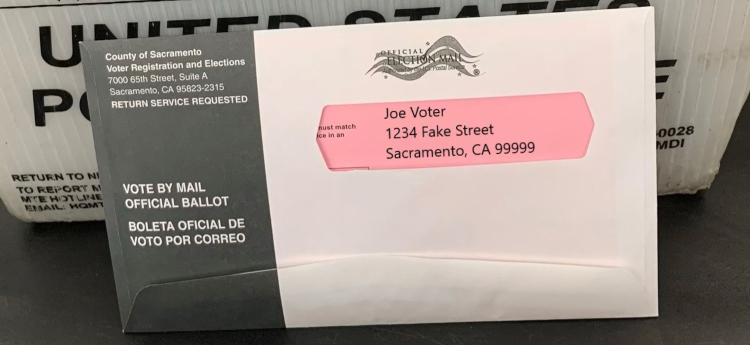
Sacramento County Vote by Mail Official Ballot. (Photo: Saccounty.net)
California’s Ballot Pamphlets Requirements
A candidate who has not voluntarily agreed to the expenditure limitations will not appear in the voter pamphlet
By Chris Micheli, January 15, 2022 6:30 pm
Ballot pamphlets are authorized in California law pursuant to Government Code Title 9, Chapter 5, Article 6, which contains Sections 85600 – 85601. Article 6 was enacted by Chapter 102 in 2000. Section 85600 requires the Secretary of State to designate in the state ballot pamphlet those candidates for statewide elective office who have voluntarily agreed to the expenditure limitations.
In addition, local elections officers are required to designate in the voter information portion of the sample ballot those candidates for State Senate and Assembly who have voluntarily agreed to the expenditure limitations.
Section 85601(a) provides that a candidate for statewide elective office who accepts the voluntary expenditure limits may purchase the space to place a statement in the state ballot pamphlet that does not exceed 250 words. However, the statement may not make any reference to any opponent of the candidate, and the statement must be submitted in accordance with timeframes and procedures set forth by the Secretary of State for the preparation of the state ballot pamphlets.
Section 85601(b) prohibits the Secretary of State from including in the state ballot pamphlet a statement from a candidate who has not voluntarily agreed to the expenditure limitations. Pursuant to Section 85601(c), a candidate for State Senate or Assembly who accepts the voluntary expenditure limits may purchase the space to place a statement in the voter information portion of the sample ballot that does not exceed 250 words. The statement may not make any reference to any opponent of the candidate.
In addition, Chapter 8 (Ballot Pamphlet) of Title 9 contains Sections 88000 – 88007. Section 88000 requires the Secretary of State to prepare a state ballot pamphlet. And Section 88001 requires the ballot pamphlet to contain all of the following thirteen items:
- A complete copy of each state measure.
- A copy of the specific constitutional or statutory provision, if any, that would be repealed or revised by each state measure.
- A copy of the arguments and rebuttals for and against each state measure.
- A copy of the analysis of each state measure.
- Tables of contents, indexes, art work, graphics, and other materials that the Secretary of State determines will make the ballot pamphlet easier to understand or more useful for the average voter.
- A notice, conspicuously printed on the cover of the ballot pamphlet, indicating that additional copies of the ballot pamphlet will be mailed by the county elections official upon request.
- A written explanation of the judicial retention procedure.
- The Voter Bill of Rights.
- If the ballot contains an election for the office of United States Senator, information on candidates for United States Senator.
- If the ballot contains a question as to the confirmation or retention of a justice of the Supreme Court, information on justices of the Supreme Court who are subject to confirmation or retention.
- If the ballot contains an election for the offices of President and Vice President of the United States, a notice that refers voters to the Secretary of State’s Internet Web site for information about candidates for the offices of President and Vice President of the United States.
- A written explanation of the appropriate election procedures for party-nominated, voter-nominated, and nonpartisan offices.
- A written explanation of the top 10 contributor lists, including a description of the Internet Web sites where those lists are available to the public.
Section 88002 requires the ballot pamphlet to contain as to each state measure to be voted upon, the following in the order set forth below:
- Upon the top portion of the first page and not exceeding one-third of the page shall appear: The identification of the measure by number and title. The official summary prepared by the Attorney General. The total number of votes cast for and against the measure in both the State Senate and Assembly if the measure was passed by the Legislature.
- The space in the title and summary that is used for an explanatory table prepared cannot be included when measuring the amount of space, the information described has taken for purposes of determining compliance with the restriction prohibiting the information described from exceeding one-third of the page.
- Beginning at the top of the right page shall appear the analysis prepared by the Legislative Analyst, provided that the analysis fits on a single page. If it does not fit on a single page, then the analysis shall begin on the lower portion of the first left page and shall continue on subsequent pages until it is completed.
- Immediately below the analysis prepared by the Legislative Analyst shall appear a printed statement that refers voters to the Secretary of State’s Internet Web site for a list of committees primarily formed to support or oppose a ballot measure, and information on how to access the committee’s top 10 contributors.
- Arguments for and against the measure shall be placed on the next left and right pages, respectively, following the page on which the analysis of the Legislative Analyst ends. The rebuttals shall be placed immediately below the arguments.
- If no argument against the measure has been submitted, the argument for the measure shall appear on the right page facing the analysis.
- The complete text of each measure shall appear at the back of the pamphlet. The text of the measure shall contain the provisions of the proposed measure and the existing provisions of law repealed or revised by the measure. The provisions of the proposed measure differing from the existing provisions of law affected shall be distinguished in print, so as to facilitate comparison.
- The following statement shall be printed at the bottom of each page where arguments appear: “Arguments printed on this page are the opinions of the authors and have not been checked for accuracy by any official agency.”
Section 88002.5(a) requires the ballot pamphlet to contain a section, located near the front of the pamphlet, that provides a concise summary of the general meaning and effect of “yes” and “no” votes on each state measure. Section 88002.5(b) requires the summary statements required by this section shall be prepared by the Legislative Analyst.
Section 88003 requires the Legislative Analyst to prepare an impartial analysis of the measure describing the measure and including a fiscal analysis of the measure showing the amount of any increase or decrease in revenue or cost to state or local government. Any estimate of increased cost to local governments must be set out in boldface print in the ballot pamphlet.
Section 88004 requires measures to be printed in the ballot pamphlet in the same order, manner and form in which they are designated upon the ballot. Section 88005 requires the ballot pamphlet to be printed according to specifications. Section 88005.5 requires the Legislative Counsel to prepare and proofread the texts of all measures and the provisions which are repealed or revised.
Section 88006 provides that, not less than 20 days before submitting the copy for the ballot pamphlet to the State Printer, the Secretary of State is required to make the copy available for public examination. Any elector may seek a writ of mandate requiring the copy to be amended or deleted from the ballot pamphlet.
Finally, Section 88007 specifies that the Legislature may without restriction amend this chapter to add to the ballot pamphlet information regarding candidates or any other information.
- Actions Against Usurping Public Office - January 1, 2026
- Voiding or Rescinding a Declaration of Minor Emancipation - January 1, 2026
- Location of a Missing Party in Child Custody Cases - December 31, 2025





Hey Chris, is there any truth here —
https://uncoverdc.com/2020/12/17/california-clearly-violated-election-law-votes-are-invalid/